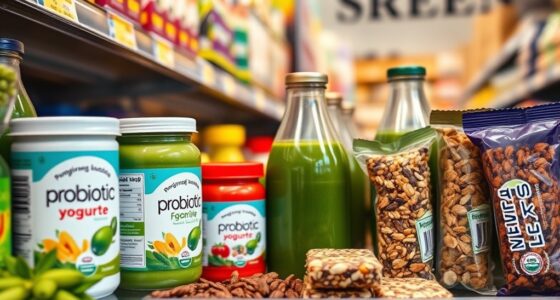Fermented foods are made when microbes like bacteria, yeast, or molds break down sugars in your food through fermentation, creating probiotics, enzymes, and beneficial compounds that support your gut and immune health. Popular options include yogurt, sauerkraut, kimchi, and kefir, which you can easily make at home. Proper techniques and safety tips guarantee success. Keep exploring to discover how to start fermenting and incorporate these healthy foods into your daily routine.
Key Takeaways
- Fermented foods like yogurt, sauerkraut, and kimchi contain live probiotics that support a healthy gut microbiome.
- Proper fermentation involves controlling temperature, salt levels, and ensuring ingredients are fully submerged to prevent spoilage.
- Regular consumption of fermented foods boosts beneficial bacteria, enhances digestion, and strengthens immune function.
- Monitoring for mold, off-odors, and uneven fermentation is essential for safe, high-quality fermented products.
- Incorporating fermented foods into your diet can improve nutrient absorption and reduce digestive discomfort.
What Are Fermented Foods and How Are They Made

Fermented foods are created through a natural process in which microbes like bacteria, yeast, or molds break down sugars and other components in the food. This process, called fermentation, transforms raw ingredients into flavorful, often tangy dishes. You might be familiar with examples like yogurt, sauerkraut, kimchi, or kombucha. During fermentation, these microbes consume sugars, producing acids, gases, or alcohol as byproducts. This not only preserves the food but also enhances its taste and texture. You typically start by adding a starter culture or relying on naturally occurring microbes present on the food or in the environment. The process can take anywhere from hours to weeks, depending on the food and desired flavor. This natural method preserves nutrients and creates unique flavors that are characteristic of fermented foods. High quality fermentation requires precise control of temperature and time to ensure optimal microbial activity and food safety. Microbial activity is influenced by environmental conditions, which need to be carefully monitored during fermentation.
The Benefits of Fermented Foods for Digestive Health

Fermented foods boost your digestive health by enhancing your body’s production of digestive enzymes, making it easier to break down food. They also help balance your gut bacteria, supporting overall digestion and immunity. Plus, consuming these foods can reduce inflammation, which often contributes to digestive discomfort. Incorporating vetted fermented foods can ensure safety and effectiveness for your gut health. Additionally, understanding the chemical processes involved in fermentation can help you select the most beneficial options. Recognizing the importance of rustic decor elements in creating a cozy kitchen environment can enhance your enjoyment of preparing and consuming fermented foods. Embracing a mental wellbeing approach can further improve your overall digestive health by fostering emotional resilience that supports healthy habits. Using self watering plant pots as a metaphor, maintaining a balanced gut environment requires consistent care and proper management.
Enhanced Digestive Enzymes
Because they contain naturally occurring enzymes, fermented foods can markedly boost your digestion by providing your body with additional tools to break down food efficiently. These enzymes help you digest proteins, fats, and carbohydrates more effectively, reducing bloating and discomfort. Consuming fermented foods like yogurt, sauerkraut, or kimchi introduces these beneficial enzymes directly into your system. Here’s a quick look at some key enzymes and their roles:
| Enzyme | Function |
|---|---|
| Protease | Breaks down proteins |
| Lipase | Digests fats |
| Amylase | Converts carbs into sugars |
| Cellulase | Breaks down plant fibers |
Adding fermented foods regularly can support your body’s natural enzyme production, enhancing overall digestive efficiency. Essential oils with anti-inflammatory properties can also support gut health and reduce digestive discomfort. Additionally, electric dirt bikes and their powerful engines illustrate how innovations can enhance performance and efficiency in various fields.
Balancing Gut Bacteria
When you include fermented foods in your diet, you actively support the balance of beneficial bacteria in your gut. These foods introduce live probiotics that help replenish and maintain your gut’s microbiome, ensuring a healthy mix of bacteria. A balanced gut bacteria population improves digestion, enhances nutrient absorption, and can even boost your immune response. Fermented foods like yogurt, kefir, sauerkraut, and kimchi contain strains of bacteria that compete with harmful microbes, preventing overgrowth and imbalance. Over time, regularly consuming these foods helps sustain diversity in your gut bacteria, which is vital for overall health. Additionally, studies suggest a correlation between certain astrological signs and perceived beauty, reflecting how self-image and confidence can influence attractiveness. By making fermented foods a part of your diet, you’re taking a proactive step toward supporting a resilient, balanced, and thriving gut ecosystem. Incorporating probiotic-rich foods can further enhance these benefits by actively introducing beneficial strains of bacteria to your digestive system, which are essential for gut health and overall well-being. Consuming these foods can also promote the production of beneficial short-chain fatty acids, supporting intestinal integrity and reducing inflammation. Engaging in a variety of self-care practices can also support your digestive health and overall vitality.
Reducing Inflammation
Did you know that incorporating fermented foods into your diet can markedly reduce inflammation in your digestive system? Fermented foods contain probiotics that help balance your gut bacteria, which plays a pivotal role in controlling inflammation. When your gut flora is healthy, it produces fewer inflammatory compounds and supports your immune response. Foods like yogurt, kimchi, sauerkraut, and kefir introduce beneficial microbes that can soothe irritated tissues and strengthen your gut lining. Additionally, seasonal variations in fermented foods can influence their effectiveness in reducing inflammation. Recognizing the role of gut bacteria in overall health underscores the importance of maintaining a balanced microbiome. Reduced inflammation means less bloating, discomfort, and a lower risk of chronic conditions like irritable bowel syndrome or inflammatory bowel disease. Incorporating fermented foods regularly can also support gut microbiome diversity, which is crucial for overall health. Regularly including fermented foods in your meals can promote a calmer, healthier digestive system, making you feel better and supporting overall well-being.
Popular Fermented Foods to Try at Home
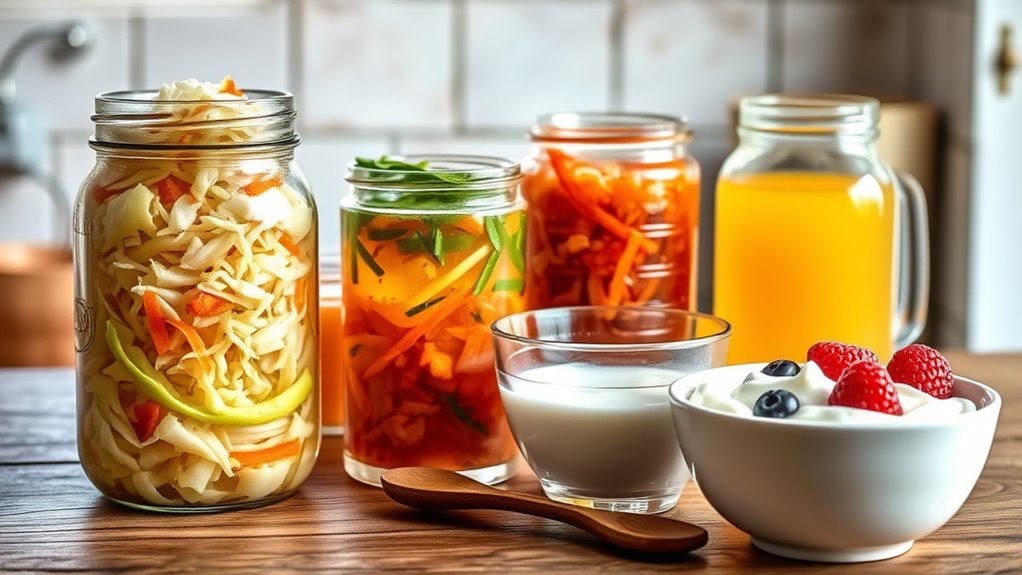
You can easily try probiotic-rich fermented foods at home, like yogurt and sauerkraut. These options are simple to make with basic fermentation techniques. Getting started is straightforward and a great way to boost your gut health.
Probiotic-Rich Options
Exploring probiotic-rich foods at home is a great way to boost your gut health naturally. Yogurt is a classic choice, packed with live cultures that support digestion. Kefir, a fermented dairy drink, offers even more probiotics and is versatile for smoothies or cereals. Sauerkraut and kimchi are fermented vegetables loaded with beneficial bacteria; add them to sandwiches or salads. Kombucha, a tangy fermented tea, provides probiotics and antioxidants, perfect for an invigorating drink. Miso, a fermented soybean paste, can enhance soups and dressings with its gut-friendly enzymes. Incorporating these foods into your diet introduces diverse strains of healthy bacteria, aiding digestion and immune function. Additionally, understanding the importance of traditional healing practices can enhance your holistic approach to health. Start with small servings and enjoy the natural benefits of these probiotic-rich options at home.
Simple Fermentation Techniques
Getting started with fermentation at home is simpler than many think, and it’s a rewarding way to create probiotic-rich foods. You don’t need fancy equipment—just basic ingredients and a few simple steps. First, choose a food to ferment, like cabbage, vegetables, or dairy. Second, prepare it by chopping or mixing, then add salt or starter culture as needed. Finally, keep it at a consistent temperature and allow fermentation to occur over days. Here are some popular options to try:
- Sauerkraut – Shredded cabbage fermented with salt.
- Yogurt – Milk fermented with a bacterial starter.
- Kimchi – Spiced vegetables fermented with probiotics.
With patience, you’ll have delicious, healthy fermented foods in no time.
How Fermentation Supports Your Immune System
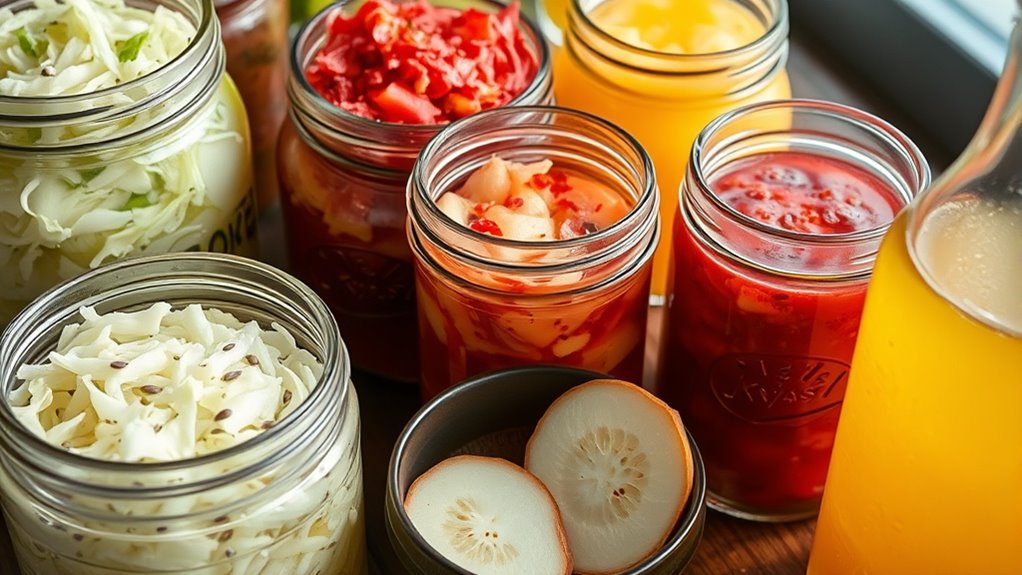
Ever wonder how fermented foods boost your immune defenses? They do this by enriching your gut with beneficial probiotics, which help balance your microbiome. A healthy gut supports immune cells, making them more effective at fighting off pathogens. Fermentation also increases the production of bioactive compounds like vitamins and antioxidants that strengthen your immune response. To see how this works, consider the following:
| Benefit | How It Helps | Example Food |
|---|---|---|
| Enhanced gut flora | Improves immune signaling | Yogurt, sauerkraut |
| Increased nutrient absorption | Boosts immune nutrients | Kombucha, kefir |
| Anti-inflammatory effects | Reduces immune system stress | Kimchi, miso |
| Production of vitamins | Supports immune cell function | Fermented vegetables |
| Strengthened gut barrier | Prevents harmful pathogens entry | Tempeh, fermented pickles |
Simple Steps to Start Fermenting in Your Kitchen
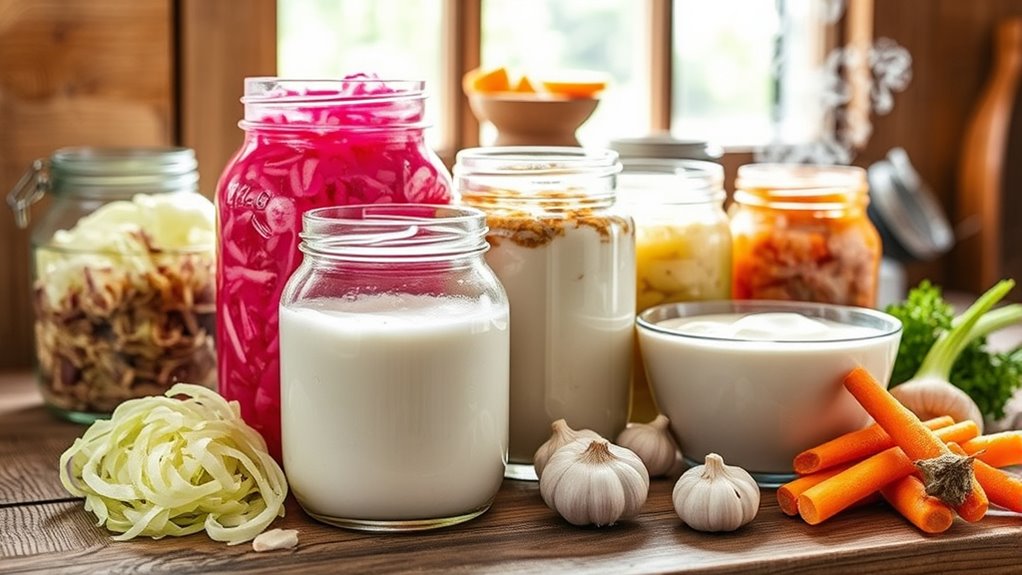
Starting to ferment at home is simpler than you might think. You don’t need fancy equipment—just basic ingredients and a little patience. Here are three easy steps to get you started:
- Choose your base: Pick vegetables, fruits, or grains like cabbage for sauerkraut or rice for fermenting drinks. Be sure to select fresh, high-quality ingredients to ensure successful fermentation and optimal probiotic development.
- Prepare your ingredients: Wash thoroughly, chop or grate, and add salt or starter cultures if needed. Proper food handling reduces the risk of contamination and spoilage.
- Ferment: Place your mixture in a clean jar, submerge it in its own liquid, and cover with a cloth or lid. Store in a cool, dark place and wait for fermentation to develop. To ensure your fermentation process goes smoothly, it’s helpful to understand how to change gears smoothly on your equipment, which can be applied to managing your fermentation timing and adjustments. Proper storage techniques also help preserve the beneficial qualities of your fermented foods and prevent spoilage.
With these simple steps, you’re on your way to enjoying homemade fermented foods that boost your gut health.
Tips for Choosing Quality Fermented Products

When selecting fermented products, always check the ingredient labels to guarantee they contain minimal additives and preservatives. Choosing organic options can also help you avoid pesticides and ensure higher quality. These simple steps make it easier to find products that truly support your gut health. Incorporating fermented foods with live probiotics can further enhance their beneficial effects on your digestive system. Additionally, opting for products from reputable appliance retailers can ensure you receive fresh, high-quality items, as their inventory often includes carefully selected and verified options. Paying attention to product freshness is crucial, as fermented foods are best enjoyed when they are at their peak quality and potency. Being mindful of storage conditions can also help maintain the probiotics’ effectiveness and prolong shelf life.
Check Ingredient Labels
To choose high-quality fermented products, it’s vital to carefully read ingredient labels. This helps guarantee you’re getting a product that supports your gut health without unnecessary additives. Here’s what to look for:
- Live and active cultures – Confirm the label mentions specific strains like Lactobacillus or Bifidobacterium, indicating probiotics are present.
- Minimal ingredients – Opt for products with simple ingredients, ideally just vegetables, salt, and water. Avoid those with artificial preservatives or flavorings.
- No added sugars – Check for low or no added sugars, which can hinder the benefits of fermentation and impact your health.
- Checking for enduring probiotic strains ensures the bacteria remain viable through the product’s shelf life and provide maximum benefits.
Reading labels carefully helps you select the best quality, most beneficial fermented foods for your gut.
Opt for Organic Options
Choosing organic fermented foods can enhance their health benefits by guaranteeing you’re getting products free from pesticides, synthetic fertilizers, and artificial additives. Organic options are often minimally processed, preserving beneficial microbes and nutrients. When shopping, look for labels that specify “certified organic” to guarantee quality. Avoid products with artificial preservatives, colorings, or flavorings, which can negate the health benefits. Organic fermented foods tend to have a richer, more authentic flavor and higher probiotic content. They also support sustainable farming practices that protect the environment. By choosing organic, you ensure you’re maximizing the natural benefits of fermentation while reducing exposure to chemicals. Incorporate these options into your diet to boost gut health and enjoy a cleaner, more nutritious product.
Incorporating Fermented Foods Into Your Daily Diet

Incorporating fermented foods into your daily diet can be a simple and effective way to boost your gut health. Start small by adding a serving of fermented foods each day to build your tolerance and enjoy the benefits. Here are three easy ways to do it:
- Add yogurt or kefir to your breakfast or smoothies for probiotics and creaminess.
- Include sauerkraut or kimchi as a side dish or topping for sandwiches and salads.
- Snack on fermented vegetables or make quick pickles to have on hand for meals.
Common Challenges When Fermenting and How to Overcome Them
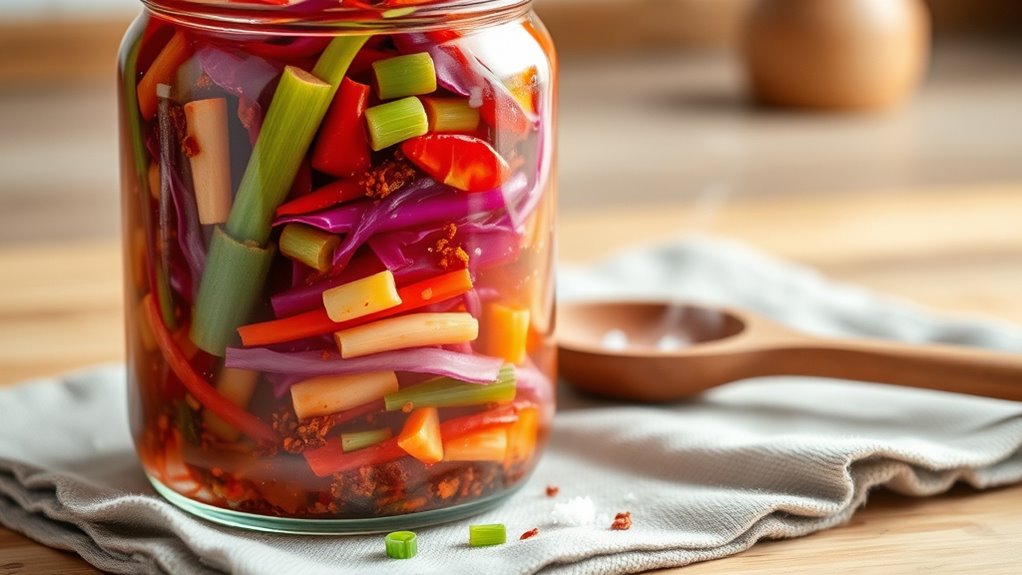
While fermenting foods can be rewarding, beginners often face common issues like mold growth, off-odors, or inconsistent results. To address these, understanding the causes helps you troubleshoot effectively. Mold usually indicates contamination; ensure your tools are clean and use proper salt concentrations. Off-odors may stem from over-fermentation or poor ingredients; taste test frequently and store in cool places. Inconsistent results often happen due to temperature fluctuations or uneven fermentation. Keep your environment stable and follow recipes closely. Here’s a quick guide:
| Issue | Cause | Solution |
|---|---|---|
| Mold growth | Contaminated tools or salt | Sterilize equipment, use correct salt levels |
| Off-odors | Over-fermentation | Reduce fermentation time, monitor temperature |
| Inconsistent results | Temperature swings | Keep fermenting area stable and consistent |
Delicious Recipes Featuring Fermented Ingredients
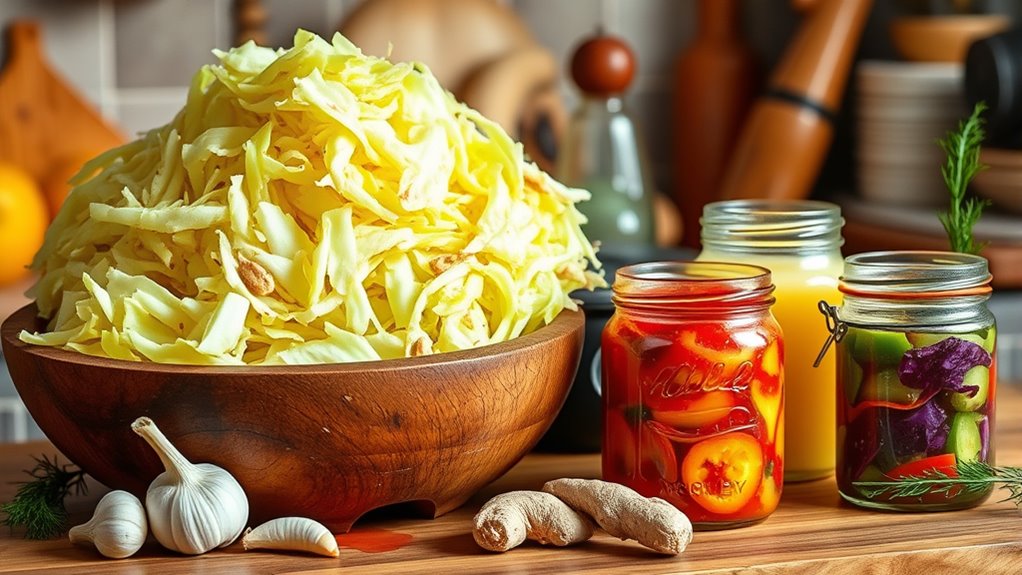
Fermented ingredients add a tangy depth and probiotic boost to a variety of delicious dishes. You can easily incorporate these flavorful elements into your cooking for both taste and gut health. Here are three tasty ideas to get you started:
- Kimchi Fried Rice – Mix chopped kimchi into fried rice for a spicy, probiotic-rich twist.
- Sourdough Pancakes – Use sourdough starter in your batter for fluffy, tangy pancakes.
- Sauerkraut Topped Hot Dogs – Add a spoonful of sauerkraut to hot dogs for a crunchy, probiotic-packed topping.
These recipes highlight how versatile fermented ingredients are, making it simple to enjoy their health benefits in everyday meals. Feel free to experiment and find your favorites!
Safety Tips and Best Practices for Fermentation

Ensuring safety during fermentation is essential to prevent spoilage and harmful bacteria growth. Always start with clean hands, utensils, and containers to minimize contamination. Use non-reactive materials like glass or food-grade plastic for your fermenting vessels. Keep your fermentation environment at a consistent temperature, ideally between 65-75°F (18-24°C), and avoid direct sunlight. Regularly check your ferment for signs of mold, foul odors, or discoloration—discard any batches showing these issues. Use the correct salt-to-water ratio and make certain your vegetables are fully submerged to prevent mold growth. Patience is key; don’t rush the process. Properly sealed jars prevent oxygen exposure, reducing the risk of spoilage. Following these best practices helps ensure your fermented foods are safe, healthy, and delicious.
Frequently Asked Questions
How Long Do Homemade Fermented Foods Stay Fresh?
You might wonder how long homemade fermented foods stay fresh. Generally, they last several months when stored properly in the fridge. Keep an eye out for signs of spoilage, like off smells or mold. Proper sealing and maintaining a consistent temperature help extend their freshness. Remember, the longer they sit, the more their flavor develops, but if you notice any changes, it’s best to discard them for safety.
Can Fermented Foods Cause Allergies or Sensitivities?
Think of fermented foods as a double-edged sword; they can boost your gut but might also trigger allergies or sensitivities. If you’re prone to food allergies, you should introduce them cautiously, watching for reactions like bloating or rashes. While rare, some people do have sensitivities to ingredients or the fermentation process itself. Always listen to your body, and consult a healthcare professional if you suspect an adverse reaction.
Are There Any Age Restrictions for Consuming Fermented Foods?
You’re wondering if there are age restrictions for eating fermented foods. Generally, most people can enjoy them safely at any age, but young children and infants should be cautious because their digestive systems are more sensitive. It’s best to consult your pediatrician before introducing fermented foods to young kids. For older adults, fermented foods can be beneficial, but if you have health concerns or allergies, check with a healthcare professional first.
How Do I Store Fermented Foods to Maintain Their Benefits?
Picture your favorite jar of sauerkraut or yogurt resting peacefully in your fridge, keeping its lively probiotics safe. To preserve their benefits, store fermented foods in airtight containers at a consistent, cool temperature—preferably between 35-40°F. Avoid frequent temperature changes and direct sunlight, as warmth and light diminish their good bacteria. Proper storage guarantees your fermented foods stay flavorful and potent, ready to boost your gut health whenever you enjoy them.
Can Fermented Foods Replace Probiotic Supplements?
You might wonder if fermented foods can replace probiotic supplements. While fermented foods like yogurt, kimchi, and sauerkraut provide beneficial probiotics, they often contain fewer strains and lower doses compared to supplements. If you’re aiming for specific health benefits or need targeted strains, supplements offer more precision. However, incorporating a variety of fermented foods can support gut health naturally and complement your probiotic routine.
Conclusion
So, now you’re practically a fermentation guru—ready to turn your kitchen into a bubbling, tangy wonderland. Just remember, not all bubbles mean success; sometimes they just mean you’ve created a mini science experiment. Keep your patience intact, follow safety tips, and embrace the occasional misstep. Before long, you’ll be bragging about your homemade kimchi and sauerkraut, all while secretly wondering if you’ve discovered the secret to eternal gut happiness. Cheers to your fermenting adventures!




